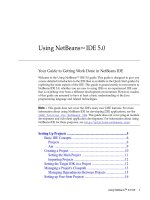Overcoming Keyword Conflicts When Using CommandBuilders
Bạn đang xem bản rút gọn của tài liệu. Xem và tải ngay bản đầy đủ của tài liệu tại đây (16.69 KB, 4 trang )
[ Team LiB ]
Recipe 4.14 Overcoming Keyword Conflicts When Using CommandBuilders
Problem
Your data includes table and column names that conflict with SQL keywords. You can
overcome this with brackets or quotes in SELECT statements that you write, but the
CommandBuilder creates illegal update statements. You need to know how to use the
CommandBuilder with your data.
Solution
Use the QuotePrefix and QuoteSuffix properties of the CommandBuilder object to
delimit database server object names containing spaces or other illegal characters.
The sample code contains two event handlers:
Preview Button.Click
Displays the delete, insert, and u
pdate commands using the delimiters specified by
the user for the QuotePrefix and QuoteSuffix properties, and either the OLE DB or
SQL Server data provider as specified by the user.
Retrieve OLE DB Button.Click
Uses the GetOleDbSchemaTable( ) method of the OleDbConnection object to
retrieve the default prefix and suffix delimiters for the data source.
The C# code is shown in Example 4-33
.
Example 4-33. File: CommandBuilderKeywordConflictForm.cs
// Namespaces, variables, and constants
using System;
using System.Configuration;
using System.Data;
using System.Data.SqlClient;
using System.Data.OleDb;
// . . .
private void previewButton_Click(object sender, System.EventArgs e)
{
String sqlText = "SELECT OrderID, ProductID, Quantity, " +
"UnitPrice, Discount FROM [Order Details]";
if (oleDbRadioButton.Checked)
{
// Build the DataAdapter and the CommandBuilder.
OleDbDataAdapter da = new OleDbDataAdapter(sqlText,
ConfigurationSettings.AppSettings["OleDb_ConnectString"]);
OleDbCommandBuilder cb = new OleDbCommandBuilder(da);
// Set the prefix and suffix.
cb.QuotePrefix = quotePrefixTextBox.Text;
cb.QuoteSuffix = quoteSuffixTextBox.Text;
// Display CommandBuilder commands with the prefix and suffix.
resultTextBox.Text =
"DeleteCommand: " + cb.GetDeleteCommand( ).CommandText +
Environment.NewLine + Environment.NewLine +
"InsertCommand: " + cb.GetInsertCommand( ).CommandText +
Environment.NewLine + Environment.NewLine +
"UpdateCommand: " + cb.GetUpdateCommand( ).CommandText;
}
else
{
// Build the DataAdapter and the CommandBuilder.
SqlDataAdapter da = new SqlDataAdapter(sqlText,
ConfigurationSettings.AppSettings["Sql_ConnectString"]);
SqlCommandBuilder cb = new SqlCommandBuilder(da);
// Set the prefix and suffix.
cb.QuotePrefix = quotePrefixTextBox.Text;
cb.QuoteSuffix = quoteSuffixTextBox.Text;
// Display CommandBuilder commands with the prefix and suffix.
resultTextBox.Text =
"DeleteCommand: " + cb.GetDeleteCommand( ).CommandText +
Environment.NewLine + Environment.NewLine +
"InsertCommand: " + cb.GetInsertCommand( ).CommandText +
Environment.NewLine + Environment.NewLine +
"UpdateCommand: " + cb.GetUpdateCommand( ).CommandText;
}
}
private void retrieveOleDbButton_Click(object sender, System.EventArgs e)
{
// Retrieve the quote prefix and suffix for the server.
OleDbConnection conn = new OleDbConnection(
ConfigurationSettings.AppSettings["OleDb_ConnectString"]);
conn.Open( );
DataTable tableSchema =
conn.GetOleDbSchemaTable(OleDbSchemaGuid.DbInfoLiterals,
new object[] {});
conn.Close( );
// Set the primary key to enable find on LiteralName column.
tableSchema.PrimaryKey =
new DataColumn[] {tableSchema.Columns["LiteralName"]};
// Get the prefix and suffix from the OleDbLiteral enumeration.
DataRow row;
row = tableSchema.Rows.Find("Quote_Prefix");
quotePrefixTextBox.Text =
((row == null) ? "" : row["LiteralValue"].ToString( ));
row = tableSchema.Rows.Find("Quote_Suffix");
quoteSuffixTextBox.Text =
((row == null) ? "" : row["LiteralValue"].ToString( ));
}
Discussion
The QuotePrefix and QuoteSuffix properties of the CommandBuilder object specify the
beginning and ending characters used to delimit database server object names, such as
tables and columns in the updating commands generated by the CommandBuilder. This is
necessary when the object names contain special characters or reserved tokens;
otherwise, the commands will fail when executed.
For example, in SQL Server 2000 and later, database object names can contain any valid
Microsoft Windows NT/2000/XP character including spaces and punctuation marks. T-
SQL is more restrictive with identifiers that can be used without delimiters. You can use
QuotePrefix and QuoteSuffix to delimit the SQL Server object names when required by
T-SQL.
The QuotePrefix and QuoteSuffix values have no effect on the CommandText of
SelectCommand. These delimiters must be specified as part of the SelectCommand that
the CommandBuilder is based on.
The default values for QuotePrefix and QuoteSuffix are empty strings.
The example demonstrates using QuotePrefix and QuoteSuffix with both the OLE DB
and SQL Server CommandBuilder objects. As you can see, they function nearly
identically.
The CommandBuilder makes it easy to update the data source with
changes made to the DataSet. Update logic is created automatically
so no understanding is required of how to code the actual delete,
insert, and update SQL statements. The CommandBuilder drawbacks
include slower performance because of the time that it takes to
request metadata and construct the updating logic, updates that are
limited to simple single-table scenarios, and a lack of support for
stored procedures. Because of these drawbacks, the CommandBuilder
is seldom used in enterprise application development.
The example also demonstrates retrieving the default quote prefix and suffix from the
database server. The GetOleDbSchemaTable( ) method of the OleDbConnection object
returns schema information from a data source based on a GUID argument indicating one
of the OleDbSchemaGuid values. The value DbInfoLiterals returns a list of provider-
specific literals used in text commands. The literals are returned as a table of rows.
Within this table, there is a column named LiteralName. The rows containing the default
values for the quote prefix and suffix are identified by a LiteralName value of
Quote_Prefix and Quote_Suffix, respectively. The actual values are stored in the
LiteralValue column.
[ Team LiB ]


![SECTION 10: FOUNDATIONS TABLE OF CONTENTS [TO BE FURNISHED WHEN SECTION IS FINALIZED]](https://media.store123doc.com/images/document/12/pt/qq/medium_dY8TJTm9cv.jpg)






